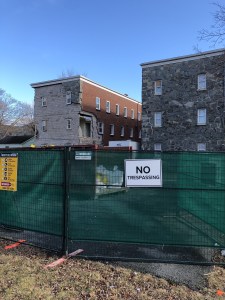How is that real estate developers get to do what they want without real consequences? Oh, right. Nothing new to see here, folks.

In mid-April 1999, a Halifax city planner named Gary Porter returned from his vacation to a surprise. He noticed there was now one more storey than the city had approved on an under-construction office building on Brunswick Street.
The developer, George Ramia, had been granted a permit to build a 40-foot-high building on the lot between Cambridge Suites and St. David’s Church. Given its slope, that meant the new building could be four storeys high on the Brunswick Street side and five storeys facing Market Street. Instead, it was already five and six storeys.
Ramia had recently applied for a development agreement to add the extra floor, but he hadn’t waited for permission before going ahead with the addition, which some critics suggested had been part of the building’s design from the beginning.

The extra floor was contentious. Heritage Trust complained the extra storey would overshadow the church, a heritage building that dated to 1868, and insisted the city enforce its own planning guidelines. The city acknowledged it did have the power to force the developer to remove the extra floor, but…
“There’s a whole lot of complications,” Porter allowed in an interview with the Halifax Daily News. “I just don’t have the answer at the moment.”
The city did issue a stop-work order, but Ramia defied it. His workers kept on laying bricks to complete the exterior of the extra storey.
“The owner has done wrong,” the city’s building inspection and enforcement coordinator, Ed Thornhill, admitted. “He’s stepped outside the limits of his permit and I’ve notified him of that… I’ve told the owner, ‘Every brick you put in there is another nail in your coffin when you go up before council.’” Thornhill threatened to refer the matter to the city’s legal department.
Still, the work continued.
The ultimate answer, of course, turned out to be simple, and too easy to anticipate.
A month and a half later, on June 2, 1999, Halifax city council voted unanimously to legalize Ramia’s illegal extra storey. There were no penalties for flouting the rules. The city’s lawyer told council that, absent forcing the developer to tear down the extra storey, the best the city could expect in court was that the developer might receive a nominal brush-on-the-wrist fine for his transgressions.
Whatever the merits of Ramia’s application, warned the Heritage Trust’s Hugh Pullen, “from a public perception point of view, this project smells.”
He wasn’t the only one to feel that way. Even the city’s deputy chief administrator at the time, George McLellan, asked, “What does this do to the integrity of our process?”
***
Flash forward more than two decades, and a few dozen blocks to the west. As Andrew Rankin reported in the Chronicle Herald on Jan. 6:
A Halifax developer continues to prepare a north-end apartment building for demolition despite having its permit revoked and an ongoing tenant dispute.
Since last week, workers have been gutting the interior of Ardmore Hall on the corner of Oxford and North Streets following an environmental assessment of the property requested by Halifax Regional Municipality.
The details are different, but the outcome is likely to be the same.

This story begins in early December when Halifax developer George Giannoulis began demolishing Ardmore Hall, a three-storey convent-turned-university-residence-turned-apartment-building. Giannoulis’s Mosaik Properties plans to replace it with a seven-storey, 130-unit building.
The problem is that a tenant still lived in one of the apartments when demolition began.
The tenant had legally challenged his Nov. 30 eviction — he claimed he’d never received legal notice to quit — and was awaiting a Dec. 16 hearing before the province’s residential tenancies board.
On Dec. 2, the landlord flooded the man’s apartment. He claimed it was accidental. In response, the city issued what is known as an “order to remedy,” requiring the landlord to fix the mess it had made. But then, just two days later, the wrecking ball smashed through the tenant’s apartment walls.
The tenant’s legal aid lawyer called it “evicting someone by demolition… It’s very disturbing and there needs to be some accountability for this.”
Ah, there’s the rub. It seems that the city, which issued the demolition permit, wasn’t aware of the ongoing tenancies board process. When the city’s compliance officers discovered what had happened, they quickly applied for and received a stop-work order. But, by then, that wall — as they say — was out of the building.
Mayor Mike Savage told the Chronicle Herald he “certainly expects that charges will be laid.” And the local councillor, Shawn Cleary, asked for a staff report to:
ensure demolition permits are not granted until such time as municipal staff are satisfied that the provincial Residential Tenancies eviction order process has reached its conclusion, including any appeals that are lawfully made by tenants.
I wouldn’t hold my breath.
Giannoulis, for his part, appeared to be merely miffed by the city’s interference in his god-given right to do as he pleases. He went to court to try to quash the city’s stop-work order, and even threatened to let the building “fall over” rather than have to reapply to finish demolition.
Joan Fraser, who lives across the street from Ardmore Hall, watched the construction debris piling up outside the site and summed up the larger situation well. “The fact that they continue to work when they were told to stop,” she told the Herald, “it’s more proof to me that developers have too much power in this city and the citizens have no say.”
Some things never change.
A version of this column originally appeared in the Halifax Examiner.
To read the latest column, please subscribe.







 STEPHEN KIMBER, a Professor of Journalism at the University of King's College in Halifax and co-founder of its MFA in Creative Nonfiction Program, is an award-winning writer, editor and broadcaster. He is the author of two novels and eight non-fiction books. Buy his books
STEPHEN KIMBER, a Professor of Journalism at the University of King's College in Halifax and co-founder of its MFA in Creative Nonfiction Program, is an award-winning writer, editor and broadcaster. He is the author of two novels and eight non-fiction books. Buy his books